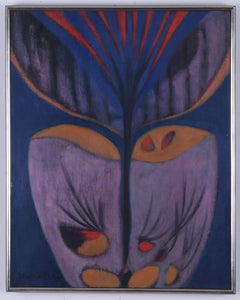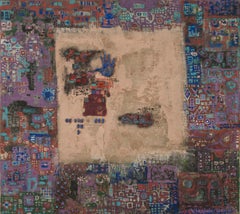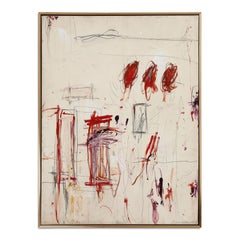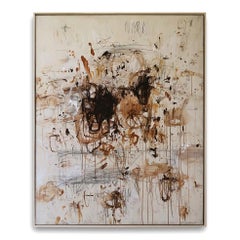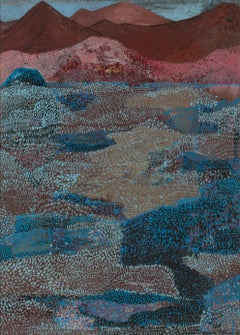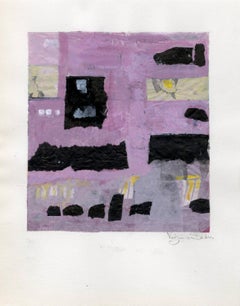Virginia Dehn Art
to
2
Overall Width
to
Overall Height
to
2
1
1
1
1
1
1
2
2
2
2
10,083
2,772
1,380
1,375
2
Artist: Virginia Dehn
Persephone
By Virginia Dehn
Located in Fairlawn, OH
Persephone
Oil on canvas, 1952
Signed lower left (see photo)
Titled reverse "Persephone" Signed "V. 52"
Exhibited: Columbus Gallery of the Arts label "71/30 Bt. 2", see label
Condition: two very small flakes of missing paint
Canvas size: 20 1/8 x 16"
Frame size: 20 7/8 x 16 3/4"
Provenance: Estate of the artist
Dehn Heirs
An important painting by the artist.
Virginia Dehn
From Wikipedia, the free encyclopedia
Virginia Dehn (1922-2005)
Virginia Dehn (née Engleman) (October 26, 1922 – July 28, 2005) was an American painter and printmaker. Her work was known for its interpretation of natural themes in almost abstract forms. She exhibited in shows and galleries throughout the U.S. Her paintings are included in many public collections.
Life
Dehn was born in Nevada, Missouri on October 26, 1922.] Raised in Hamden, Connecticut, she studied at Stephens College in Columbia, Missouri before moving to New York City. She met the artist Adolf Dehn while working at the Art Students League. They married in November 1947. The two artists worked side by side for many years, part of a group of artists who influenced the history of 20th century American art. Their Chelsea brownstone was a place where artists, writers, and intellectuals often gathered.
Early career
Virginia Dehn studied art at Stephens College in Missouri before continuing her art education at the Traphagen School of Design, and, later, the Art Students League, both located in New York City. In the mid-1940s while working at the Associated American Artists gallery, she met lithographer and watercolorist Adolf Dehn. Adolf was older than Virginia, and he already enjoyed a successful career as an artist. The two were married in 1947 in a private ceremony at Virginia's parents house in Wallingford, Connecticut.
Virginia and Adolf Dehn
The Dehns lived in a Chelsea brownstone on West 21st Street where they worked side by side. They often hosted gatherings of other influential artists and intellectuals of the 20th century. Among their closest friends were sculptor Federico Castellón and his wife Hilda; writer Sidney Alexander and his wife Frances; artists Sally and Milton Avery; Ferol and Bill Smith, also an artist; and Lily and Georges Schreiber, an artist and writer. Bob Steed and his wife Gittel, an anthropologist, were also good friends of the Dehns. According to friend Gretchen Marple Pracht, "Virginia was a glamorous and sophisticated hostess who welcomed visitors to their home and always invited a diverse crowd of guests..." Despite their active social life, the two were disciplined artists, working at their easels nearly daily and taking Saturdays to visit galleries and view new work.
The Dehns made annual trips to France to work on lithographs at the Atelier Desjobert in Paris. Virginia used a bamboo pen to draw directly on the stone for her lithographs, which often depicted trees or still lifes. The Dehns' other travels included visits to Key West, Colorado, Mexico, and countries such as Greece, Haiti, Afghanistan, and India.
Dehn's style of art differend greatly from that of her husband, though the two sometimes exhibited together. A friend of the couple remarked, "Adolf paints landscapes; Virginia paints inscapes." Virginia Dehn generally painted an interior vision based on her feelings for a subject, rather than a literal rendition of it.] Many of her paintings consist of several layers, with earlier layers showing through. She found inspiration in the Abstract Expressionism movement that dominated the New York and Paris art scenes in the 1950s. Some of her favorite artists included Adolf Gottileb, Rothko, William Baziotes, Pomodoro, and Antonio Tapies.
Dehn most often worked with bold, vibrant colors in large formats. Her subjects were not literal, but intuitive. She learned new techniques of lithography from her husband Adolf, and did her own prints. Texture was very important to her in her work. Her art was influenced by a variety of sources. In the late 1960s she came across a book that included photographs of organic patterns of life as revealed under a microscope. These images inspired her to change the direction of some of her paintings. Other influences on Dehn's art came from ancient and traditional arts of various cultures throughout the world, including Persian miniatures, illuminated manuscripts, Dutch still life painting, Asian art, ancient Egyptian artifacts...
Category
1950s American Modern Virginia Dehn Art
Materials
Acrylic
Kandahar
By Virginia Dehn
Located in Fairlawn, OH
Kandahar
Acrylic and mixed media on fabric, c. 1970
Signed by the artist lower right (see photo)
Kandahar is one of the thirty-four provinces of Afghanistan, located in the southern part of the country next to Pakistan. Inspired by the Dehns visit to Afghanistan in the 1960's.
Provenance: Estate of the Artist
Dehn Heirs
Condition: Excellent
Canvas size: 18 x 20 inches
Virginia Dehn
From Wikipedia, the free encyclopedia
Virginia Dehn
Virginia Dehn in her studio in Santa Fe
Virginia Dehn (née Engleman) (October 26, 1922 – July 28, 2005) was an American painter and printmaker. Her work was known for its interpretation of natural themes in almost abstract forms. She exhibited in shows and galleries throughout the U.S. Her paintings are included in many public collections.
Life
Dehn was born in Nevada, Missouri on October 26, 1922.] Raised in Hamden, Connecticut, she studied at Stephens College in Columbia, Missouri before moving to New York City. She met the artist Adolf Dehn while working at the Art Students League. They married in November 1947. The two artists worked side by side for many years, part of a group of artists who influenced the history of 20th century American art. Their Chelsea brownstone was a place where artists, writers, and intellectuals often gathered.
Early career
Virginia Dehn studied art at Stephens College in Missouri before continuing her art education at the Traphagen School of Design, and, later, the Art Students League, both located in New York City. In the mid-1940s while working at the Associated American Artists gallery, she met lithographer and watercolorist Adolf Dehn. Adolf was older than Virginia, and he already enjoyed a successful career as an artist. The two were married in 1947 in a private ceremony at Virginia's parents house in Wallingford, Connecticut.
Virginia and Adolf Dehn
The Dehns lived in a Chelsea brownstone on West 21st Street where they worked side by side. They often hosted gatherings of other influential artists and intellectuals of the 20th century. Among their closest friends were sculptor Federico Castellón and his wife Hilda; writer Sidney Alexander and his wife Frances; artists Sally and Milton Avery; Ferol and Bill Smith, also an artist; and Lily and Georges Schreiber, an artist and writer. Bob Steed and his wife Gittel, an anthropologist, were also good friends of the Dehns. According to friend Gretchen Marple Pracht, "Virginia was a glamorous and sophisticated hostess who welcomed visitors to their home and always invited a diverse crowd of guests..." Despite their active social life, the two were disciplined artists, working at their easels nearly daily and taking Saturdays to visit galleries and view new work.
The Dehns made annual trips to France to work on lithographs at the Atelier Desjobert in Paris. Virginia used a bamboo pen to draw directly on the stone for her lithographs, which often depicted trees or still lifes. The Dehns' other travels included visits to Key West, Colorado, Mexico, and countries such as Greece, Haiti, Afghanistan, and India.
Dehn's style of art differend greatly from that of her husband, though the two sometimes exhibited together. A friend of the couple remarked, "Adolf paints landscapes; Virginia paints inscapes." Virginia Dehn generally painted an interior vision based on her feelings for a subject, rather than a literal rendition of it.] Many of her paintings consist of several layers, with earlier layers showing through. She found inspiration in the Abstract Expressionism movement that dominated the New York and Paris art scenes in the 1950s. Some of her favorite artists included Adolf Gottileb, Rothko, William Baziotes, Pomodoro, and Antonio Tapies.
Dehn most often worked with bold, vibrant colors in large formats. Her subjects were not literal, but intuitive. She learned new techniques of lithography from her husband Adolf, and did her own prints. Texture was very important to her in her work. Her art was influenced by a variety of sources. In the late 1960s she came across a book that included photographs of organic patterns of life as revealed under a microscope. These images inspired her to change the direction of some of her paintings. Other influences on Dehn's art came from ancient and traditional arts of various cultures throughout the world, including Persian miniatures, illuminated manuscripts, Dutch still life painting, Asian art, ancient Egyptian artifacts...
Category
1970s Abstract Virginia Dehn Art
Materials
Acrylic
Related Items
"Divine Spontaneity II" Acrylic, Oil Pastels, Pencils Abstract Painting 48"x36"
By Karina Gentinetta
Located in New York, NY
"Divine Spontaneity II" 2023, 48" H x 36" W. Vertical abstract painting consisting of acrylics, house paint, oil pastels, color pencils, and carbon pencils on canvas by Argentine-bo...
Category
21st Century and Contemporary Abstract Expressionist Virginia Dehn Art
Materials
House Paint, Acrylic, Carbon Pencil, Oil Pastel, Color Pencil
$11,000
H 49.5 in W 37.5 in D 2.5 in
"Petite Adagio in Burnt Umber" Acrylic, Oil Pastels, Pencils in Browns 60"x48"
By Karina Gentinetta
Located in New York, NY
"Petite Adagio in Burnt Umber" 2025, 60" H x 48" W. Abstract, mixed media painting consisting of acrylic, pencils, and oil pastels on canvas by Argentine-born artist Karina Gentinett...
Category
21st Century and Contemporary Abstract Expressionist Virginia Dehn Art
Materials
Oil Pastel, Acrylic, Carbon Pencil, Color Pencil
$16,500
H 61.5 in W 49.5 in D 3 in
"Ranunculus III" Acrylic, Oil Pastels and Pencils Rose Pink Abstract 60"x60"
By Karina Gentinetta
Located in New York, NY
"Ranunculus III", 2025, 60" H x 60" W. Abstract painting in a deep rose, magenta hue consisting of acrylic, pencils, and oil pastels on canvas by Argentine-born artist Karina Gentine...
Category
21st Century and Contemporary Abstract Expressionist Virginia Dehn Art
Materials
Oil Pastel, Acrylic, Carbon Pencil, Color Pencil
$18,500
H 61.5 in W 61.5 in D 2.5 in
"Ranunculus II" Large Acrylic, Oil Pastels, Pencils Blush Rose Abstract 84"x60"
By Karina Gentinetta
Located in New York, NY
"Ranunculus II", 2024, 84" H x 60" W. Large-scale abstract painting in hues of blush crimson consisting of acrylic, pencils, and oil pastels on canvas by Argentine-born artist Karina...
Category
21st Century and Contemporary Abstract Expressionist Virginia Dehn Art
Materials
Oil Pastel, Acrylic, Carbon Pencil, Color Pencil
$28,000
H 85.5 in W 61.5 in D 2.5 in
Urban Abstraction (ripped off posters) Italian Expressionist Painting on Canvas
By Andrea Spinelli
Located in Firenze, IT
The present work of art titled "Urban Abstraction (ripped off posters)" is part of a series of paintings that the artist composed in the 1980s and 1990s inspired by the observation of the urban reality of those years.
The artist take the cue from his walks in Florence, both in the center and in the suburbs, and by the observation of billboards and posters scattered throughout the city.
The mass of information, colors, messages and words were carried on the canvas with acrylic colors, ideally reconstructing the tears and overlaps of all the information and advertising contained on these huge sheets of paper that invade our cities.
The geometric lines are overlaid with jagged lines, overlaps and color dripping and also the choice in the color palette, with different shades of white, gray, rose, orange red and blue helps in rendering the result of the tears and ripped paper.
The result is a beautiful multicolored modern abstract canvas, both aesthetically and ethically, with many rich layers of color, texture and expression in which the artist leaves his own message.
The painting is housed in a simple modern white lacquer wood frame.
Andrea Spinelli...
Category
Late 20th Century Abstract Expressionist Virginia Dehn Art
Materials
Canvas, Acrylic
$1,434
H 20.87 in W 32.68 in D 1.19 in
"Adagio in Burnt Umber" Acrylic, Oil Pastels, Pencils Brown Hue Abstract 72"x60"
By Karina Gentinetta
Located in New York, NY
"Adagio in Burnt Umber" 2025, 72" H x 60" W. Abstract, mixed media painting consisting of acrylic, pencils, and oil pastels on canvas by Argentine-born artist Karina Gentinetta (feat...
Category
21st Century and Contemporary Abstract Expressionist Virginia Dehn Art
Materials
Oil Pastel, Acrylic, Carbon Pencil, Color Pencil
$20,000
H 73.5 in W 61.5 in D 3 in
Shanty Town
By Robert Noel Blair
Located in Buffalo, NY
You are viewing a modernist American acrylic painting depicting a charming but rundown seaside town at night.
Robert Noel Blair (American, 1912-2003) was an American artist, paint...
Category
1950s American Modern Virginia Dehn Art
Materials
Acrylic, Archival Paper
"Verdigris" Large Scale Acrylic, Oil Pastels and Pencils Green Abstract 84"x60"
By Karina Gentinetta
Located in New York, NY
"Verdigris" 2025, 84" H x 60" W. A captivating large-scale abstract painting by Argentine-born artist Karina Gentinetta, renowned for her work featured in Architectural Digest, Elle...
Category
21st Century and Contemporary Abstract Expressionist Virginia Dehn Art
Materials
Oil Pastel, Acrylic, Carbon Pencil, Color Pencil
$28,000
H 85.5 in W 61.5 in D 2.5 in
Untitled-006 abstract painting by Fred Martin
By Fred Martin
Located in Hudson, NY
Exhibited:
2003 Oakland Museum of California "Fred Martin Retrospective"
A native Californian, Fred Martin was born in San Francisco in 1927, and received both his BA (1949) and MA (1954) from University of California, Berkley. At the San Francisco Art Institute Martin studied with Clyfford Still, Mark Rothko and David Park...
Category
1970s American Modern Virginia Dehn Art
Materials
Masonite, Pastel, Acrylic
Abstract B1
Located in San Juan, PR
CARLOS MERCADO
ABSTRACT
Inspired in the work of Franz and Ives Klein
This body of work was produced during the initial months of the lock down due to the pandemic. This tragedy crea...
Category
2010s Abstract Virginia Dehn Art
Materials
Canvas, Acrylic
"Bodacious" Large Black, Blue, Mint, White, Raw Sienna, Pink Abstract 72"x72"
By Karina Gentinetta
Located in New York, NY
"Bodacious" 2023, 72" x 72" square. An oversized, large-scale, bold and dramatic abstract painting consisting of acrylic, house paint, pencils, and oil pastels on canvas by Argentine...
Category
21st Century and Contemporary Abstract Expressionist Virginia Dehn Art
Materials
Oil Pastel, Acrylic, Color Pencil, House Paint
Karina Gentinetta"Bodacious" Large Black, Blue, Mint, White, Raw Sienna, Pink Abstract 72"x72", 2023
$24,000
H 73.5 in W 73.5 in D 2.25 in
"Rhapsody in Red" Large-Scale Acrylic, Oil Pastels, Pencils Abstract 72"x60"
By Karina Gentinetta
Located in New York, NY
"Rhapsody in Red", 2025, 72" H x 60" W. Large-scale abstract painting in hues of a warm, desaturated crimson consisting of acrylic, pencils, and oil pastels on canvas by Argentine-bo...
Category
21st Century and Contemporary Abstract Expressionist Virginia Dehn Art
Materials
Oil Pastel, Acrylic, Carbon Pencil, Color Pencil
$20,000
H 73.5 in W 61.5 in D 2.5 in
Previously Available Items
Untitled (Landscape with foothills and mountains)
By Virginia Dehn
Located in Fairlawn, OH
Signed by the artist in ink lower right
Category
Mid-20th Century Surrealist Virginia Dehn Art
Materials
Watercolor
Untitled
By Virginia Dehn
Located in Fairlawn, OH
Signed by the artist in pencil lower right
Category
1970s Abstract Virginia Dehn Art
Materials
Watercolor
Virginia Dehn art for sale on 1stDibs.
Find a wide variety of authentic Virginia Dehn art available for sale on 1stDibs. If you’re browsing the collection of art to introduce a pop of color in a neutral corner of your living room or bedroom, you can find work that includes elements of blue and other colors. You can also browse by medium to find art by Virginia Dehn in paint, acrylic paint, synthetic resin paint and more. Much of the original work by this artist or collective was created during the 20th century and is mostly associated with the modern style. Not every interior allows for large Virginia Dehn art, so small editions measuring 7 inches across are available. Customers who are interested in this artist might also find the work of Robert Andrew Parker, Pawel Kontny, and Stanley Twardowicz. Virginia Dehn art prices can differ depending upon medium, time period and other attributes. On 1stDibs, the price for these items starts at $950 and tops out at $6,500, while the average work can sell for $1,950.
